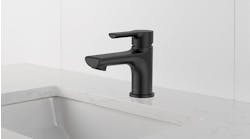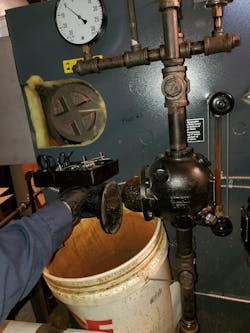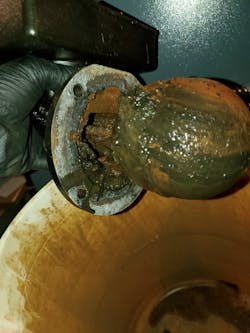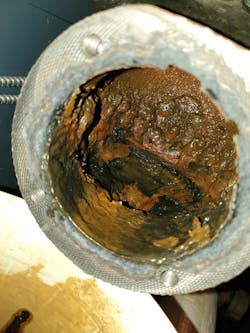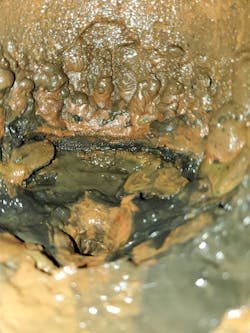Latest from Hydronics
Sponsored
Years ago, when I was younger and Ronald Reagan was POTUS, a low water cut-off (LWCO) on a steam boiler had a float and not a probe, whether it was residential or commercial. Today, most residential steam boilers use a probe style LWCO. For those of you that aren’t so familiar with steam heating, a LWCO is the safety device that eventually shuts off the burner if the water level in the boiler gets too low.
Bad things happen when there isn’t enough water in a steam boiler and the burner is on. When there is water, the heat from the burner transfers through the metal to heat the water to a temperature to produce steam. Without any water in the boiler to absorb the heat, the runaway burner gets the cast iron or steel heat exchanger too hot. In the industry, the condition is called dry-fire.
How it Works
In photo 1, you see the controls side view of a commercial steam boiler with the float style LWCO taken apart. The float style LWCO consists of three parts, a float chamber, a float, and a switch(s). The float chamber is connected to the boiler with equalizing lines, positioned above and below the normal water line of the boiler, which is determined by the boiler manufacturer. The float chamber is on the right and still piped in, while the float and switches are on the left, pulled out of the float chamber for inspection.
The LWCO shown has two switches that operate at different water levels, but connected to the same float. As the water level drops in normal operation, the float drops and the first switch makes contact, typically turning on a boiler feed pump to return water to the boiler and raise the water line back to its operating level. Residentially, the switch may operate an electric feed valve. When it reaches the proper level, the switch opens to shut the pump/valveoff.
This cycle can repeat several times during a call for heat. We want the burner to be on and the boiler making steam for the complete call for heat. Interruptions of steam production cause uneven heat and high fuel bills.
Let’s say the water level continues to drop because the pump didn’t work. The float should continue to drop and the second switch should then open to shut off the burner, protecting the metal from dry-fire. All that works fine when it’s fresh and new. But sludge/muck happens.
And How it Goes Wrong
What doesn’t show in photo 1 is the “blow down” valve. Below the float camber should be a quick opening valve, typically a quarter turn to open ball-style valve. While the burner is on, that valve should be rapidly opened, the discharge going into a bucket rather than on your boots. Turn the valve closed when the burner shuts off. Done on a regular basis, the float chamber doesn’t accumulate much muck and the safety is proven.
In photo 2, we see some muck build up on the float, which can make the float heavy, keeping it from rising up with the actual water level. This could keep the boiler feed pump onIn photo 3, we see muck build up inside the float chamber. Somebody wasn’t blowing down this LWCO on a regular basis. The most common result of that build up causes the dry fire, since enough build up over time in the float chamber can keep the float from actually dropping. If the float can’t drop because of the build-up of the muck, the boiler feed pump can’t refill the boiler and the LWCO switch can’t turn off the burner. When all the water boils off and the burner is still roaring, something bad is going to happen.
In photo 4, we see a close up of the muck in the float chamber and the constricted opening in the bottom that connects to the blow down valve. Looks like it wouldn’t have been long before that closed up and kept the muck in the chamber.
Inspection is Key
This commercial size boiler was in a large residence rather than in a school building. Most institutional boilers are subject to an annual inspection which includes taking apart the LWCO to check for muck build up in the float chamber.
Unfortunately, residential boilers are only subject to the level of maintenance of the homeowner, for good or bad. Luckily this homeowner got help and the technician found this condition early enough to prevent a boiler dry-fire. If you take over maintenance on a steam boiler that has a float style LWCO, take it apart to check for muck before you get stuck with some explaining to do.
On a personal note, it seems that my retirement may be delayed once again. The Kid, who I am training to take over my job, informed me of this recently. He had just sunk a birdie putt on the second hole and was feeling pretty good about himself. His plan is for me to keep working while he’s on the pro tour. Granted, he can hit the long 300 yard drives that are a sight to behold and the high approach shots that get lost in the clouds, but he can’t get his chip shot to check up on the second bounce. If he masters that, I might be around for a 50 year career.
Patrick Linhardt is a thirty-seven-year veteran of the wholesale side of the hydronic industry who has been designing and troubleshooting steam and hot water heating systems, pumps and controls on an almost daily basis. An educator and author, he is currently Hydronic Manager at the Corken Steel Products Co.
Patrick Linhardt
Patrick Linhardt is a forty-one-year veteran of the wholesale side of the hydronic industry who has been designing and troubleshooting steam and hot water heating systems, pumps and controls on an almost daily basis. An educator and author, he is currently Hydronic Manager at the Corken Steel Products Co.

